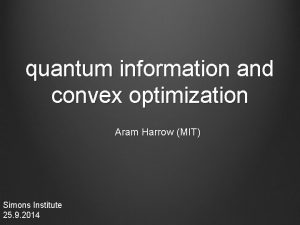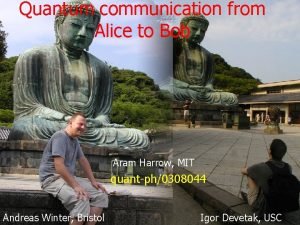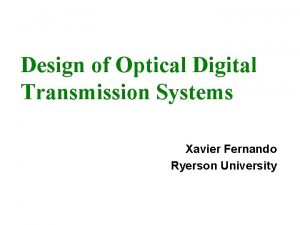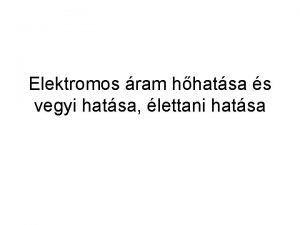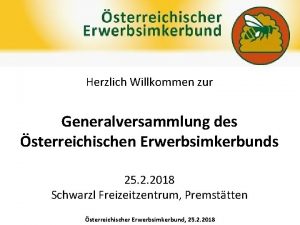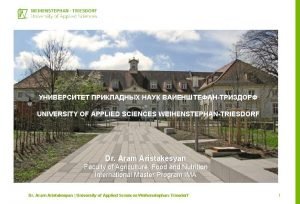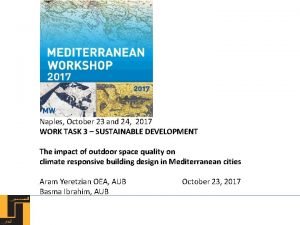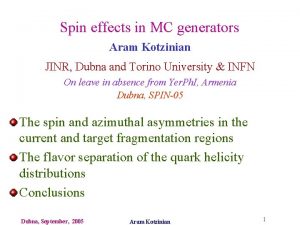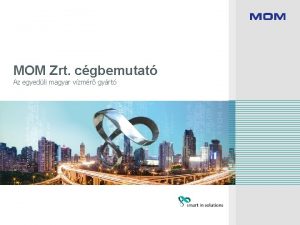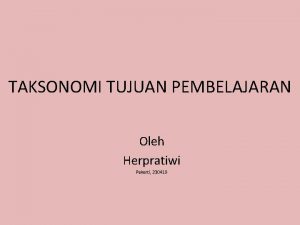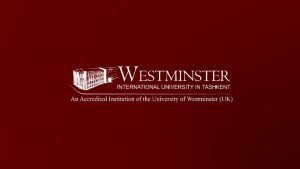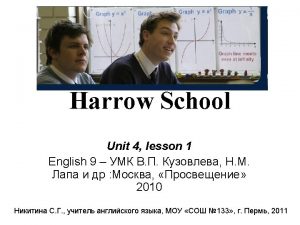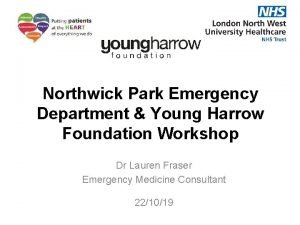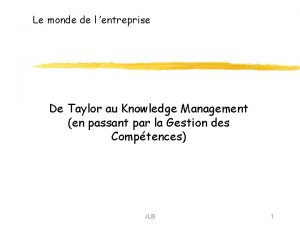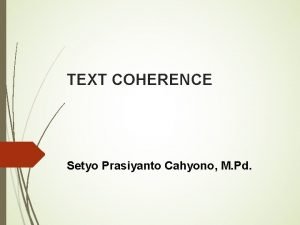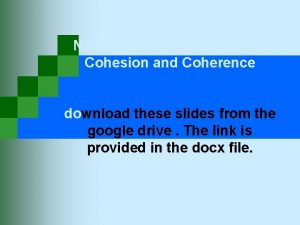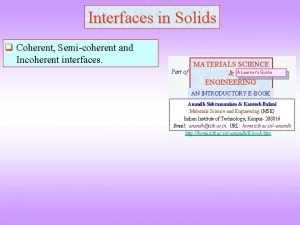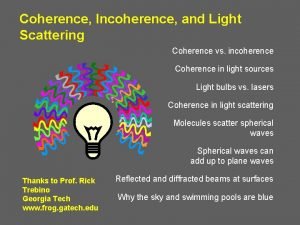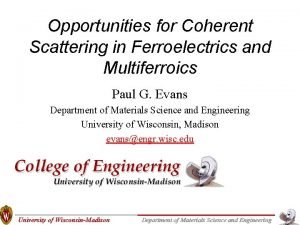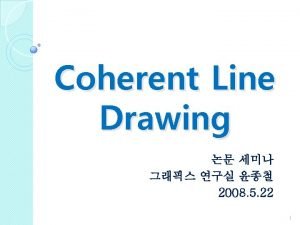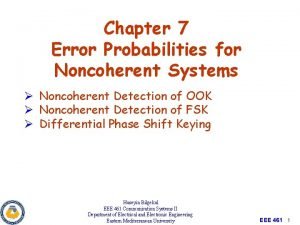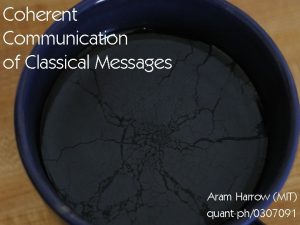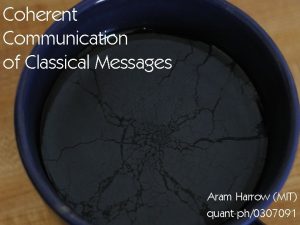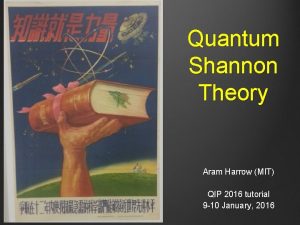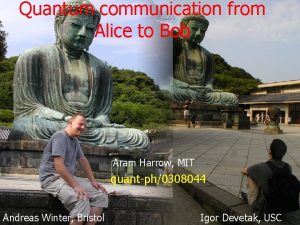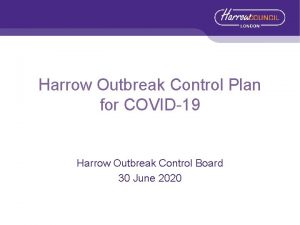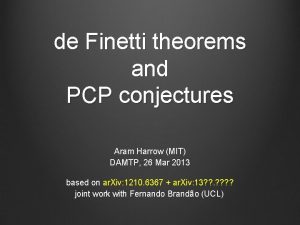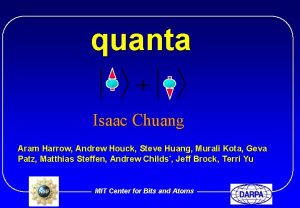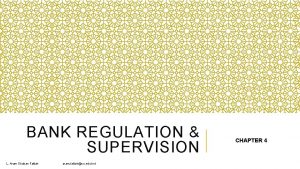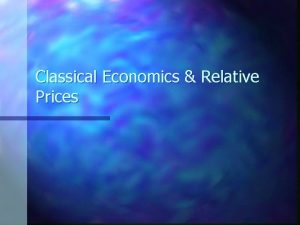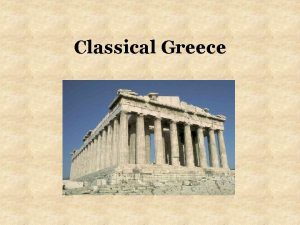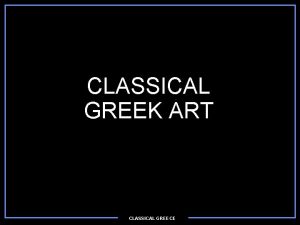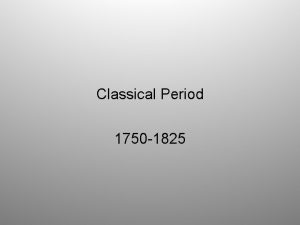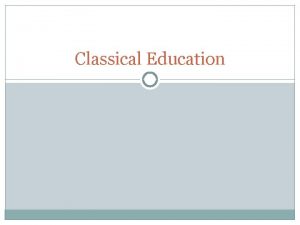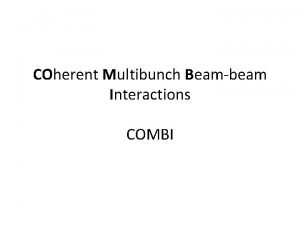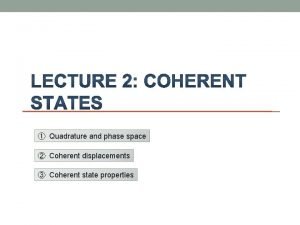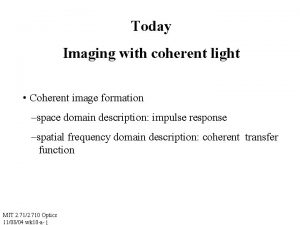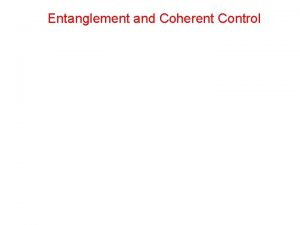Coherent Communication of Classical Messages Aram Harrow MIT










![cobit: |xi. A!|xi. A|xi. B noisy sources of cobits [Devetak, Harrow, Winter; quant-ph/0308044] General cobit: |xi. A!|xi. A|xi. B noisy sources of cobits [Devetak, Harrow, Winter; quant-ph/0308044] General](https://slidetodoc.com/presentation_image_h2/00eb028b6ad2598487c50d1436866237/image-11.jpg)


















- Slides: 29

Coherent Communication of Classical Messages Aram Harrow (MIT) quant-ph/0307091

outline • What is coherent communication? • Why should you care about it? • Where can you obtain it? • How can you use it?

beyond qubits and cbits Let {|xi}x=0, 1 be a basis for C 2. • qubit: |xi. A!|xi. B • cbit: |xi. A!|xi. B|xi. E • coherent bit (cobit): |xi. A!|xi. A|xi. B • ebit: |Fi=2 -1/2åx|xi. A|xi. B 1 qubit > 1 cobit > 1 cbit 1 qubit > 1 cobit > 1 ebit

motivation

cobit: |xi. A!|xi. A|xi. B motivation #1 irreversibility in q. info. theory 1 qubit > 1 ebit and 1 qubit > 1 cbit are both individually optimal, but the best way to generate qubits is 2 cbits + 1 ebit ¸ 1 qubit. Super-dense coding and teleportation appear to be dual, but composing them wastes entanglement. Claim: Irreversibility comes from the transformation “ 1 cobit > 1 cbit. ”

cobit: |xi. A!|xi. A|xi. B motivation #2 communication with unitary gates Suppose Alice can send Bob n cbits using a unitary interaction (i. e. U|xi. A|0 i. B ¼ |xi. B|yxi. AB for x 2{0, 1}n). This must be more powerful than an arbitrary noisy interaction, because it implies the ability to create n ebits. But what exactly is its power? Claim: Unitary interactions send cobits while general interactions send cbits.

Q: qubits sent per use of channel motivation #3: quantum channel capacity with limited entanglement qubit > ebit bound I(A: B)/2 = (H(A) + H(B) - H(AB))/2 [BSST; quant-ph/0106052] 45 o Ic =H(B) - H(AB) [L/S/D] H(A)+I(A: B) E: ebits allowed per use of channel

Q: qubits sent per use of channel motivation #3 quantum channel capacity with limited entanglement I(A: B)/2 = (H(A) + H(B) - H(AB))/2 “father protocol” 45 o [DHW; quant-ph/0308044] Ic =H(B) - H(AB) [LSD] I(A: E)/2 = (H(A) + H(AB) - H(B))/2 E: ebits allowed per use of channel

cobit: |xi. A!|xi. A|xi. B sources of cobits Super-dense coding: 1 qubit + 1 ebit > 2 coherent bits Z X H

cobit: |xi. A!|xi. A|xi. B sources of cobits Distributed unitary gates: If U is a unitary gate or isometry and U > C cbits, then U > C coherent bits. Examples: CNOT > cobit(!) CNOT > cobit(Ã) CNOT + ebit > cobit(!) + cobit(Ã) Y Z H
![cobit xi Axi Axi B noisy sources of cobits Devetak Harrow Winter quantph0308044 General cobit: |xi. A!|xi. A|xi. B noisy sources of cobits [Devetak, Harrow, Winter; quant-ph/0308044] General](https://slidetodoc.com/presentation_image_h2/00eb028b6ad2598487c50d1436866237/image-11.jpg)
cobit: |xi. A!|xi. A|xi. B noisy sources of cobits [Devetak, Harrow, Winter; quant-ph/0308044] General rule: If N can send a classical message that is nearly independent of the residual state (of Alice, Bob and environment), then that message can be made coherent. Example: entanglement-assisted classical capacity [BSST] N + H(A) ebits > I(A: B) cbits Ux N D The environment always sees a maximally mixed state! N + H(A) ebits > I(A: B) cobits ¼|xi. B|yxi. BE

Teleportation uniformly H random X Z 2 cbits + 1 ebit > 1 qubit + 2 rbits Before measuring, the state is 2 -1åab|ai|bi. AZa. Xb|yi. B.

cobit: |xi. A!|xi. A|xi. B Teleportation with coherent communication 2 -1åab|abi. A|abi. BZa. Xb|yi. B H coherent comm. 2 -1åab|abi. AZa. Xb|yi. B X Z 2 cobits +1 ebit > 1 qubit + 2 ebits

cobit: |xi. A!|xi. A|xi. B Simple consequences • 2 coherent bits = 1 qubit + 1 ebit (C) (using entanglement catalytically) • Teleportation and super-dense coding are no longer irreversible. • N + H(A) ebits > I(A: B) cobits = I(A: B)/2 (qubit + ebit) H(A) - I(A: B)/2 = (H(A) + H(E) - H(B))/2 = I(A: E)/2 father: N + I(A: E)/2 ebits > I(A: B)/2 qubits

cobit: |xi. A!|xi. A|xi. B general rule for using cobits Simultaneous communication and entanglement generation Suppose X + C cbits > Y and the classical message sent is independent of the output state. Then X + C coherent bits > Y + C ebits

cobit: |xi. A!|xi. A|xi. B Recycling in the remote CNOT = H cbit (!)+ cbit(Ã) + ebit > CNOT [Gottesman, quant-ph/9807006] cobit (!)+ cobit(Ã) + ebit > CNOT + 2 ebits cobit (!)+ cobit(Ã) = CNOT + ebit (C) SWAP = qubit(!) + qubit(Ã) = 2 CNOT (C)

Remote State Preparation 1 cbit + 1 ebit > 1 remote qubit (A) Given |Fdi and a description of |yi 2 Cd, Alice can prepare |yi in Bob’s lab with error e by sending him log d + O(log d)/e 2) cbits. [Bennett, Hayden, Leung, Shor and Winter, quant-ph/0307100]

RSP protocol k

Neumark’s theorem: any measurement can be made unitary k UA

cobit: |xi. A!|xi. A|xi. B Entanglement recycling in RSP discard UA coherent communication of log n bits

cobit: |xi. A!|xi. A|xi. B Coherent RSP 1 cobit + 1 ebit > 1 remote qubit + 1 ebit 1 cobit > 1 remote qubit (C) Corollary 1: Super-dense coding of quantum states 1 qubit + 1 ebit > 2 remote qubits (C) (Independent direct proof in [Harrow, Hayden, Leung; quant-ph/0307221]. ) Corollary 2: The remote state capacity of a unitary gate equals its classical capacity.

RSP of entangled states (e. RSP) Let E={pi, |yii. AB} be an ensemble of bipartite pure states. Define S(E)=S(åipi. Tr. Ayi), E(E)=åipi. S(Tr. Ayi), c(E)=S(E)-E(E). e. RSP: c(E) cbits + S(E) ebits > E (A) [BHLSW] make it coherent: c(E) cobits + E(E) ebits > E (A)

Unitary gate capacities Define Ce to be the forward classical capacity of U assisted by e ebits of entanglement per use, so that 1 use of U + e ebits > Ce cbits (A) Solution: Ce=sup. E {c(UE) - c(E) : E(E) - E(UE)6 e} (In [BHLS; quant-ph/0205057], this was proved for e=1. )

Warmup: entanglement capacity Define E(U) to be the largest number satisfying U > E(U) ebits (A). Claim: E(U) = sup|yi E(U|yi) – E(|yi) Proof: [BHLS; quant-ph/0205057] |yi + U > U|yi > E(U|yi) ebits (concentration) >|yi + E(U|yi)-E(|yi) ebits (dilution) Thus: U > E(U|yi)-E(|yi) ebits (A)

Coherent HSW coding Lemma: Let E={pi, yi} be an ensemble of bipartite pure states that Alice can prepare in superposition. Then E > c(E) cobits + E(E) ebits (A) Proof: Choose a good code on E n. Bob’s measurement obtains ¼nc(E) bits of Alice’s message and determines the codeword with high probability, causing little disturbance. Thus, this measurement can be made coherent. Since Alice and Bob know the codeword, they can then do entanglement concentration to get ¼n. E(E) ebits.

Protocol achieving Ce E + U > UE > c(UE) cobits + E(UE) ebits (coherent HSW) > E + (c(UE)-c(E)) cobits + (E(UE)-E(E)) ebits (coherent RSP) Thus, U + (E(E)-E(UE)) ebits > (c(UE)-c(E)) cobits (A)

Quantum capacities of unitary gates Define Qe(U) to be the largest number satisfying U + e ebits > Qe qubits. Using 2 cobits = 1 qubit + 1 ebit, we find

References A. W. Harrow. “Coherent Communication of Classical Messages” quant-ph/0307091 I. Devetak, A. W. Harrow and A. Winter. “A family of quantum protocols. ” quant-ph/0308044

Conclusions • Whenever a classical message is independent of the residual Alice-Bob-environment state, it can be made coherent. • 2 coherent bits = 1 qubit + 1 ebit • consequences include: super-dense coding of [entangled] quantum states, SWAP=2 CNOT, classical and quantum capacities of unitary gates, tradeoff curves for quantum channel capacities and the asymptotic equivalence of ensembles of bipartite pure states.
 Aram harrow
Aram harrow Aram harrow
Aram harrow Coherent detection in optical communication
Coherent detection in optical communication Elektromos áram kémiai hatása
Elektromos áram kémiai hatása Aram ghadimi
Aram ghadimi Aram aristakesyan
Aram aristakesyan Aram yeretzian
Aram yeretzian Aram generator
Aram generator Mom mátészalka
Mom mátészalka Contoh tujuan pembelajaran ranah kognitif
Contoh tujuan pembelajaran ranah kognitif Dixie harrow
Dixie harrow Objective liability offences
Objective liability offences Harrow boys school
Harrow boys school Northwick park emergency department
Northwick park emergency department Prof. ferdousi begum
Prof. ferdousi begum Taxonomie bloom verbes
Taxonomie bloom verbes Anita harrow psychomotor domain
Anita harrow psychomotor domain First minima in diffraction
First minima in diffraction Coherent text
Coherent text Cohesive presentation
Cohesive presentation Coherent scattering
Coherent scattering Cohesion and coherence
Cohesion and coherence Coherent interface
Coherent interface Coherent vs incoherent scattering
Coherent vs incoherent scattering Cew paragraph example
Cew paragraph example Coherent scattering
Coherent scattering Open capi
Open capi Pulse frequency
Pulse frequency Edge tangent flow
Edge tangent flow Probability of error for non coherent fsk
Probability of error for non coherent fsk
